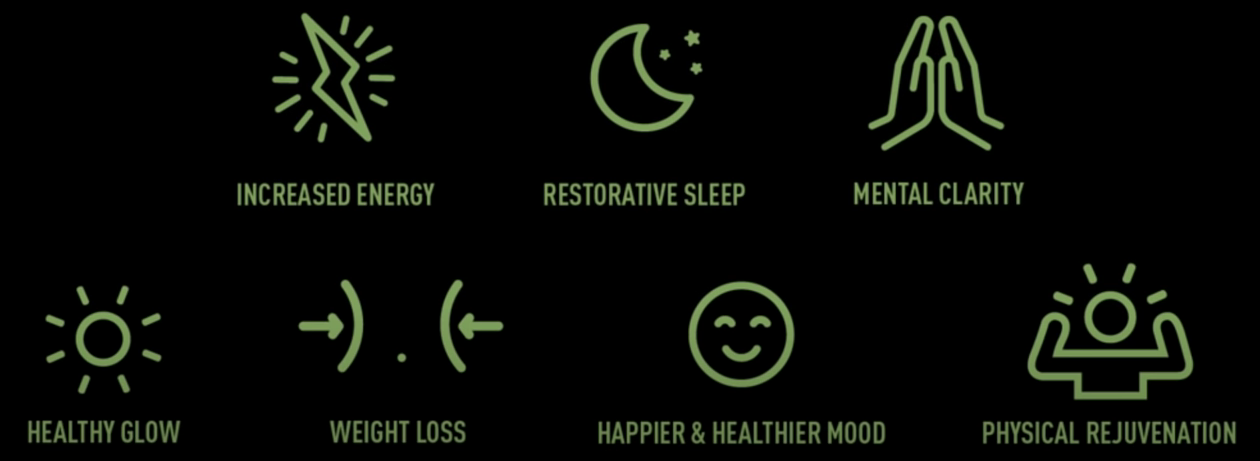
Before jumping in, consider joining my private Health, Longevity & Fasting Facebook group! We’re an active community that do monthly group fasting challenges.
DISCLAIMER: The information I provide at troydelaney.com is not intended to replace consultation with a qualified medical professional. If you have a medical condition or health questions, seek the advice of your physician or qualified health provider.
The content provided is not intended to be relied upon for medical diagnosis or treatment. Inform your physician of any changes you may make to your diet or lifestyle. Do not disregard medical advice or delay visiting a medical professional because of something you read on my site or on my other communication channels.
For questions or concerns about any medical conditions you may have, please contact your doctor.
INTRO
When you eat is just as important as what you eat, especially for liver and cognitive health. In fact, Intermittent Fasting (IF) and Time Restricted Feeding (TRF) are probably the two most important and potent tools to promote healthy aging and longevity, as well as improve and maintain ideal body composition (weight loss and muscle gain), optimize performance and just feeling energized and amazing.
You might be thinking that you could never “starve yourself” or that it sounds extreme and unhealthy. But if you apply fasting in a way that supports your lifestyle, it is actually the most natural thing you can do for your body and mind.
In fact, integrating fasting properly into your lifestyle might even allow you to get away with a diet that isn’t entirely ideal. [1a]
I emphasize “properly” because, as Dr. Ronesh Sinha eloquently puts it, “fasting is a drug that comes in different formulations and doses and must be personalized and prescribed just like a drug, if we are using it therapeutically to achieve a specific goal (weight loss, reduce cholesterol, etc.).” Many people don’t incorporate the right exercise or sufficient protein (among other common mistakes), which can lead to muscle loss, along with other negative effects, when not done properly.
Ultimately, a fasting lifestyle gives you two things: freedom and flexibility.
The purpose of this comprehensive guide is to get you up to speed with what fasting can do for you, lay out your options, and help you get started right away with the best fasting option for you based on your desired goals and intentions.
If you’re ready to jump right in and skip the details, click on GETTING STARTED.
The process is also designed to help you integrate fasting into a healthy lifestyle, not just to use fasting as a “crash diet”. If you’re interested in a fast track to a fasting lifestyle, coaching, group accountability and more, check out my 28-DAY RESET program.
Many people fast for spiritual reasons but, as you’ll find out, there are many more reasons to implement a fasting routine and could be the cornerstone to a long and healthy life.
The thought of intentionally skipping a meal, or worse yet, an entire day of eating, may make some people shutter in horror. This is especially true since we’ve been mislead to believe that we must eat “three square meals”, sometimes even as many as six meals a day, and snacks in between. That’s A LOT of food!
But the truth is, humans have fasted since the beginning of our species and across all cultures, whether for religious purposes or out of necessity during times of scarcity.
In fact, our species have evolved specific adaptations to deal with those periods of famine. We’re hardwired to be able to survive and even thrive with some regular fasting incorporated into our lives.
A growing body of evidence suggests that fasting can actually supercharge your brain, burn unwanted belly fat and trigger a biological reset. I’ll cover how to fast safely, effectively and with as little suffering as possible.
Before I get into all the details, make sure to join my private facebook group, Fast to PERFORM here: https://www.facebook.com/groups/fasttoperfrom/
Ok, let’s jump in…
FASTING: AN OVERVIEW
What is Fasting?
Fasting is the elimination, or significant reduction of calories for a set period of time. Simple, right?
Why Fast?
If you’re like a majority of people, you’re probably grazing throughout the day, taking in calories for 12+ hours, never truly taking a break from “feasting”. Although it goes against what you’ve probably been taught, this habit of grazing throughout the day and evening, having continuous access to [processed] food and being in a constant “digest” mode has serious ramifications for health and longevity, as it:
- Raises your risk for inflammation, hypertension and various chronic diseases
- Prevents effective digestion and elimination of waste
- Prevents your body’s natural housekeeping and rejuvenation processes
- Prevents metabolic flexibility, the efficient switching from using sugar to fat for fuel
- Increases fat storage, as you’re loading your body with energy even when it doesn’t need it
- Harms your cells’ DNA, mitochondria, membranes and proteins
- Lowers your body’s resistance to stress and disease
Benefits of Fasting
It might sound like a magic pill, but something free (possibly less than free since you’ll save money on food) can:
- Improve attractiveness by eliminating unwanted body fat, improve body composition and promote clearer skin.
- Make you feel amazing, not only through an increase in confidence through a leaner body but also can improve digestive health, allergies and chronic pain while reducing food cravings and creating a better relationship with food.
- Improve health through metabolic balance, improved gut health and reduced risk of chronic diseases.
- Optimize performance though a clearer mind, rejuvenated body and increased energy.
- Extend lifespan and promote anti-aging effects through a boost in growth hormones and stem cells, replacing damaged cells and organs.
How is that possible?
Cellular House-Cleaning
It is believed by many scientists that a continuous stream of food prevents autophagy, the waste-removal process of cells, causing accumulated cellular debris which is one cause of the major causes of chronic disease associated with aging.
Fasting promotes cellular autophagy. During autophagy, the body cleans house and starts regenerating itself—eliminating dysfunctional, damaged cells to make room for new, healthy ones.
Autophogy is linked to repair and rejuvenation that may provide critical elements in optimizing lifespan (how long you live), healthspan (how well you live) and anti-aging because it keeps cells young, healthy, and functioning optimally. [1b] This cellular clean-up appears in the body and the brain [2] so it is linked to healthy cognitive function as well.
Stem Cell-Based Regeneration & DNA Reset
As mentioned above, fasting enhances the body’s natural process of cellular renewal through the release of stem cells to replace the eliminated damaged cells. It can also increase the secretion of the brain hormone BDNF which aids the growth of new nerve cells [6]. The body creates new white blood cells and gets rid of bad proteins in the muscle and stem cells replace those tissues. [3] DNA is also reset by “bad” genes being turned off (obesity genes, allergy etc.). [4]
Mental & Physical Resiliency & Stress Resistance
Fasting activates the body’s protective and stress resistant mode.
As Mark Mattson with the National Institute on Aging explained to the Canadian Medical Association Journal, cells are under “mild stress” during a period of fasting. [5] Cells respond to the stress adaptively by enhancing their ability to cope with stress and, maybe, to resist disease.
He likens the stress fasting puts on cells to that placed on your muscles and heart during exercise: it’s an immediate shock to the system that allows your body to get stronger over time.
Going without food is more psychological than physical and overcoming that psychological hurdle builds mental resilience and strength.
Improved Body Composition / Weight Loss
Fasting for periods of 12 hours or more has been shown to improve fat oxidation and induce mild ketosis, which means the body is using fat for fuel. [6] Whole-day fasts have been shown to reduce body weight and body fat. [7] Additionally, fasting has been shown to help us regulate ghrelin, the “hunger hormone” [8] which allows leptin, the “feel full hormone” to normalize and appetite to balance out (this is generally observed more often in males).
Metabolic Flexibility
Fuel switching (aka metabolic switching) refers to the preferential shift from the use of glucose (sugar) as a fuel source to the use of fatty acids and ketone bodies (fat). Your ability to efficiently toggle back and forth between these two metabolic states is an indicator of your metabolic flexibility.
Metabolic flexibility is often referred to as being “fat-adapted” or “keto-adapted”. Fat-adaptation is the normal, preferred metabolic state of the human animal; fat on our bodies are a pretty reliable source of energy. But it’s more difficult to access stored fat for energy when you’re dependent on sugar, which most people are due to a constant intake of carbohydrates.
Fasting for periods of 12 hours or more has been shown to improve fat oxidation and induce mild ketosis, which means the body is using fat for fuel [9].
If your body can’t use fat for fuel efficiently, the dietary fat you eat is stored rather than burned for energy, which can lead to an increase in body fat.
Ketone bodies produced from fasting are not only used for fuel, but are also signaling molecules [10] that have profound effects on metabolism and are known to influence health and aging [11].
Becoming metabolically flexible leads to:
- Improved insulin sensitivity. [12]
- Effectively oxidize dietary fat for energy, which means you can probably go between meals without becoming ravenous
- Genes associated with lipid metabolism will be up-regulated in your skeletal muscles, essentially reprogram your body to burn fat
- You can rely more on fat for energy during exercise, sparing glycogen for when you really needs it
- Once the fat-burning machinery has been established and programmed, you should be able to effortlessly switch between fuel sources as needed
Most importantly, the more metabolically flexible we are, the less we have to micromanage our macronutrients and calories. We can just eat and, as long as we stick to whole foods, the satiety signaling we receive will generally be accurate and reliable.
Metabolic Health, Disease Prevention & Reversal
Fasting may be a good tool to treat or prevent a number of metabolic maladies. Autophagy induced my fastng may offer protection against diseases like cancer, cardiovascular or cognitive diseases (dementia, Alzheimer’s, Parkinson’s). [13, 14, 15, 16]
Fasting has been shown to improve a number of blood lipid markers [9] including blood pressure, cholesterol, blood sugar, and triglycerides. Fasting also appears to protect the body against the negative effects of oxidative stress and inflammation. (17) Fasting can improve insulin sensitivity and lower overall levels of blood sugar [18].
Optimized Physical & Mental Performance
As counterintuitive as it might sound, energy levels and mental clarity tend to increase during times of fasting, potentially as a way to give the body a boost to go hunt down a sabertooth tiger.
Fasting has also been shown to increase the body’s secretion of human growth hormone (HGH) [19], which aids in preserving muscle and burning body fat.
Gut & Immune Health
Fasting can give your digestive system a break from constantly working. It can also protect the gut against the negative impacts of stress and can lead to increased microbial diversity and elevated rates of fermentation [20], making your gut and immune system stronger. A kind of “microbiome reset” also takes place as the ratio of good/bad bacteria change, helping with food cravings, losing weight and keeping it off. [21a]
Types of Fasting
The two main forms of fasting are Time-Restricted Feeding (TRF), and Intermittent Fasting (which includes 5:2, alternate-day fasting and prolonged fasting). Intermittent fasting, in a broad sense, refers to the process of voluntarily cycling between periods of fasting and non-fasting whereas TRF includes engaging in a daily fast between dinner and breakfast the next day, for at least 12 hours.
Time Restricted Feeding (TRF)
Time Restricted Feeding/Eating, often improperly referred to Intermittent Fasting, is the act of compressing your daily eating window to two to 12 hours, meaning you eat all of your calories for the day during those two to 12 hours, and for the remaining 12 to 22 hours, you’re fasting. Water, black coffee and unsweetened tea during the fasting period are typically fine.
Even if you eat high-quality food, if you’re grazing for 16 hours a day, you’re sabotaging your health. TRF may even allow you to get away with a diet that isn’t entirely ideal [21b], as it blocks many of the harmful effects of a poor diet, likely because you’re regularly activating autophagy (the cleanup of aging and damaged cells). That’s right, merely changing the meal timing and restricting the number of hours you eat, and also by moving to an earlier eating schedule produce huge benefits even in the same person eating the same meals.
This is also one of the simplest things you can do to prepare for an extended fast, but more on that later.
TRF is more a lifestyle than a diet because you don’t have to follow any specific approach exactly. TRF can be as formal or informal as you like and you technically don’t count calories or even restrict them.
While TRF may not induce significant changes in processes such as cellular senescence and stem cell renewal (like an extended fast would), it has been found to improve metabolic health, a critical predictor of healthy aging. [22]
Time-restricted eating exploits the body’s innate 24-hour patterns – the genetically encoded molecular clocks present in every cell, from the complex (liver cells) to the simple (hair follicles) – and provides the body an essential downtime where it can focus on cellular repair and restoration rather than digestion. As such, time-restricted eating may trigger some beneficial health effects, such as reduced fat mass, increased lean muscle mass, reduced inflammation, improved heart function with age, increased mitochondrial volume, ketone body production, improved repair processes, and enhanced aerobic endurance.
— Dr. Rhonda Patrick, Found My Fitness
According to a recent study [23], TRF may also help with motivation to engage in voluntary exercise (which will help with STEP 6). And if you can exercise BEFORE you break your fast, you may burn more fat [24], even if it’s just light exercise like a 20 minute morning walk.
TRF is not recommended for kids, teens, and pregnant or lactating women.
SUMMARY of TRF
- Fasting for metabolic health/weight loss: can be beneficial
- Fasting for gut rest: can be beneficial
- Fasting for energy or mental clarity: can ben beneficial
- Fasting for longevity/cell clean-up: can be beneficial for longevity although longer fasts are required for cellular clean-up
TIMING OPTIONS
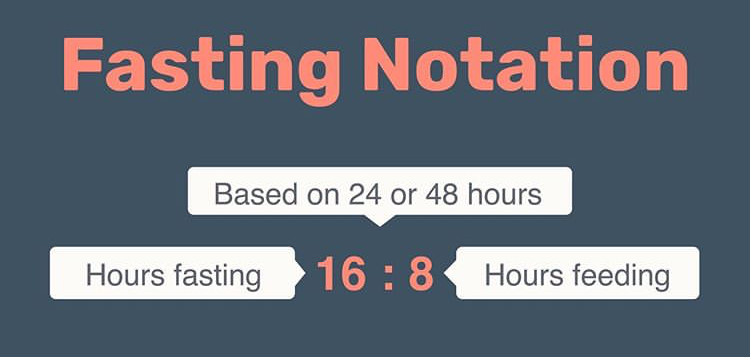
12:12 aka Circadian Rhythm or Overnight Fasting
- Fast: From sundown to sunup
- Feed: From sunup to sundown
14:10, 16:8, 18:6, etc.
- Fast: Usually for 14 hours or more; typically skipping breakfast or dinner.
- Feed: Usually for 10 hours or less.
This type of TRF, particularly an 8-hour feeding window, has been found to help obese individuals lose weight and lower their systolic blood pressure. [25a] 18:6 is where we see a metabolic switch from glucose-based to ketone-based energy. [25b]
20:4 aka Warrior Diet
- Fast: Usually for 20 hours or more
- Feed: Usually for 4 hours or less.
Popularized by nutritional and fitness expert Ori Hofmekler, it extends the fasting block to 20 hours and shrinks the eating window down to just four hours, specifically four hours at night. However, the approach doesn’t mandate fasting completely for all 20 hours: the Warrior Diet encourages some snacking throughout the day, by munching on things like raw fruits and vegetables. Then, it suggests a feast at night, usually in the form of a large dinner. Although Time Restricted Feeding has been greatly researched, this specific approach lacks the scientific studies to back it up.
One Meal A Day (OMAD)
- Fast: Most of the day, usually 22 hours or more
- Feed: One meal, usually 2 hours or less. It may be best to eat breakfast or lunch to ensure proper sleep. If you choose dinner, ensure it’s at least 3 hours prior to bedtime.
A couple words of caution regarding OMAD:
Although OMAD was shown in one study to have a significant modification of body composition, including reductions in fat mass and a significant decrease in concentrations of cortisol, that same study also showed significant an increase in hunger, significant increases in blood pressure and in total, LDL-, and HDL-cholesterol concentrations. [25a]
Other studies have shown that eating one meal per day may increase fasting blood sugar levels, delay the body’s response to insulin, and increase levels of the appetite-stimulating hormone ghrelin, compared to eating 3 meals per day.
This can lead to extreme hunger. [25b]
In addition, eating one meal a day can lead to symptoms including [25c]:
- nausea
- dizziness
- irritability
- low energy
- constipation
- increased chances of low blood sugar, especially in those with type 2 diabetes [25d]
What’s more, it can be very difficult to take in enough nutrients in one meal. This can lead to nutrient deficiencies, which can negatively affect your health and can lead to serious risks.
OPTIMAL TIMING
A 12-16 hour fasting window seems to be ideal for most people. Females tend to do better with longer feeding windows, like 10-12 hours. Dr. Valter Longo tends to err with caution and recommends sticking to 12 hours of fasting. There is some evidence that longer fasting can cause a lack of bile leading to gall bladder issues, especially in combination with a low fiber diet. [25e]
With regards to eating earlier or later, one study [26a] looked at what they called “early TRF” (eTRF). eTRF refers to shifting the feeding window earlier in the day. This study suggests that it is ideal to eat earlier and end earlier. Earlier meal timing can also result in more lipid oxidation (fat burning) according to a randomized crossover trial. [26b] So if your goal is weight loss, try to eat an early dinner or avoid it all together, although socially, it is much easier to skip breakfast and enjoy a dinner with friends and family.
Intermittent Fasting
Short Fasts (24-36 Hours)
Fasting for 24 hours for as little as once or twice a month or as much as once or twice per week. Several variations of this method have been popularized in recent years. It’s best to test each out and find what works for you.
Alternate-Day Fasting (ADF)
Periodic ADF (ADF or 36:12) consists of fasting (water-only or restricted calories (aka modified fasting, typically 25% of “total energy needs”) every other day (typically for 24-36 hours) followed by a full day of normal eating within a 12-hour window. ADF in humans has been found to improve both improve metabolic health by promoting improved blood glucose management, blood lipid profiles, and metabolic flexibility [27] while also reducing weight [28]. ADF also stimulates autophagy in animal and cell studies.
However, it is not a feasible or healthy long-term approach for most people. [28a] Dr. Jason Fung outlines this approach in his book, The Complete Guide to Fasting.
5:2 Fasting
The 5:2 diet is similar to ADF: two days of complete or modified fasting, consuming 500 to 600 calories each of those days, and five days of normal food intake.
Eat, Stop, Eat dictates day-long fasts twice a week as well.
Modified fasting where someone consumes a small amount of calories on the fasting days is considered much more sustainable than doing full fasts on fasting days, but it’s just as effective.
KetoFast
The KetoFast, created by Dr. Joseph Mercola, combines a very-low-carb diet with a six to eight hour Time-Restricted Feeding window and a “refeed” higher-carb day. Note that this specific approach lacks the scientific studies to back it up.
Prolonged / Extended Fasts
Longer multi-day fasts, (typically 48+ hours) give your cells the benefit of enhanced autophagy and more time to regenerate and optimize their function. This type of fasting is less frequently referred to as Intermittent Fasting, but is true Intermittent Fasting (fasting periodically for a set period of time).
The duration of fasting needed to activate processes that are linked to healthy aging in humans is currently unknown. However, a minimum of 24 hours is generally required to boost these processes in mice, which have a higher metabolism than humans. It is thus reasonable to assume that we may need to fast for multiple days at a time to achieve these more dramatic anti-aging health benefits.
For general health and longevity goals, prolonged fasts between 3-10 days are believed to be ideal in order to take full advantage of the benefits. You may consider longer if you are fasting for therapeutic, weight loss or spiritual reasons. It’s recommended to work with a medical provider before undertaking a fast longer than two days.
This type of long-term food deprivation can set off a unique set of metabolic events, such as deeper ketosis as glycogen stores are depleted, which may result in some degree of cellular and systemic clean-up through programs such as apoptosis and autophagy. A typical periodic fast in the research setting lasts between 48 hours and up to 96 hours (four days).
— Dr. Rhonda Patrick, Found My Fitness
Dr. Peter Attia believes 3 days is probably the minimum amount of time needed to hit some of the important physiologic benchmarks such as…
- Glycogen depletion which leads to…
- Inhibition of mTOR
- Activation of AMPK
- A significant reduction of glucose and insulin that triggers autophagy and the inhibition of senescent cells
In essence, the real benefit to prolonged fasting (3+ days) versus shorter term fasts (24-72hrs) is the ability to fully “activate” the stress resistance response associated with fasting (autophagy, rejuvenation, etc.). The extra two days past the three day mark recommended by Dr. Valter Longo are believed necessary to take full advantage of those benefits, not just “dip” into them. He believes this is the timeframe when autophagy up-regulates and cellular regeneration peaks. Cognitive function improvement is also frequently reported, likely due to the brain shifting to using ketones for fuel vs glucose.
You can read about my first fasting experience and why I choose to do the ProLon FMD in this article and also read my full ProLon review here.
Water-Only

Water-only is pretty self-explanatory – you only drink water.
Some people add a high-quality sea salt like Celtic salt or a trace mineral supplement to ensure adequate electrolytes are being consumed
Coffee and tea my be acceptable though many purists will recommend nothing other than distilled water, particularly if doing it for therapeutic reasons. Some people will go with decaf coffee or herbal teas to take a break from caffeine. This is what I recommend as it serves as a good caffeine reset. You can learn more about how to properly do a caffeine reset in this article.
Pros
- It’s free
- There may be benefits to water-only fasting over the FMD that have not been discovered
- Humans have done water-only for millennia
- Great for those fasting for mental fortitude, spiritual reasons, or looking for a complete gut reset
Cons
- Compliance can be difficult
- Muscle preservation is debatable
- No rigorous clinical trials have conducted
Fasting Mimicking Diet (FMD) / Low-Calorie Fasting
Does the concept of multi-day fasting scare you away?
If it does, no worries! Research suggests there are other “fasting-mimicking” practices that may help us achieve similar effects. Scientist Valter Longo’s Fasting Mimicking Diet (FMD) is one such option. The FMD involves significantly reducing your total calorie intake for three to five days each month; after this three- to five-day period, regular eating habits are resumed for the remainder of the month. This constitutes one cycle of the FMD. The FMD cycles are continued until desired health results are achieved. In preclinical studies of the FMD, it has been found to reverse immunosuppression, a critical factor that contributes to aging. [29]
The FMD mitigates the burden and danger of water-only fasting by providing a tasty, convenient and safe dietary program that does not require ongoing lifestyle changes, such as long-term dieting.
While most people can safely practice time-restricted eating, periodic fasting may be more appropriate to do under the guidance of a physician. As a safer alternative, Dr. Valter Longo has pioneered an approach that may recapitulate many of the same effects of prolonged fasting with a hyper-low calorie, low protein, higher fat diet stretched out over a longer interval of five days – a diet called the Fasting-Mimicking Diet. Fasting-mimicking recapitulates humans’ ancient patterns of exposure and response to famine and feast, providing a means of cellular renewal and disease protection.
— Dr. Rhonda Patrick, Found My Fitness
The ProLon FMD is a 5-day meal kit in the proper macros and calories that was developed and studied by Dr. Longo. The kit contains five small boxes (one for each day) that include plant-based energy bars, soups, a variety of snacks, drinks, and supplements, all studied and carefully designed to nourish your body and support healthy levels of metabolic markers, cellular rejuvenation, and healthy aging. It’s the easiest and most convenient way to do the FMD. You can get the best price on kits here: www.prolonfmd.com/TroyDelaney
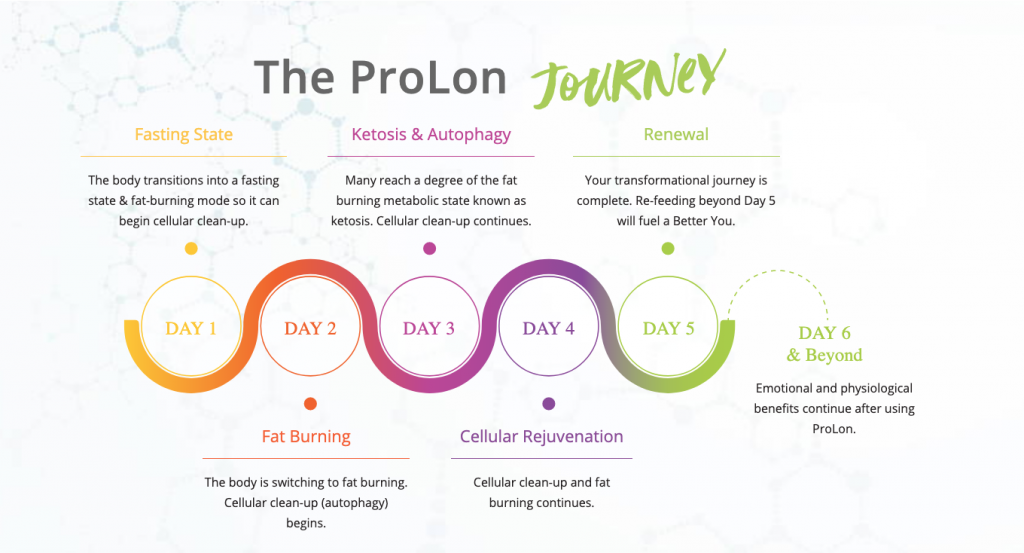
ProLon is the first and only clinically tested, doctor recommended fasting meal program. Over $36 million and 20 years of extensive studies sponsored by the National Institutes of Health (NIH) and conducted at the Longevity Institute and Diabetes and Obesity Research Institute of the University of Southern California resulted in the development of the first FMD (ProLon) which stimulates:
- The body’s protective and stress resistant mode
- Autophagy for the clean-up of old and damaged cells
- The body’s natural process of cellular clean-up and cell renewal
Fasting Expert Interview: ProLon Fasting Mimicking Diet with Dr. James Kelley (read the show notes here)
There are DYI versions of the ProLon FMD which can save you money but it definitely requires more work and it may be a little stressful preparing the food while you’re fasting. Also keep in mind that the DYI versions have not been tested to the same rigor as ProLon’s clinical trials — there are no guarantees of results like the results shown in ProLon’s clinical trials.
To maximize on the benefits of the FMD, consider doing it once a month for three months in a row with 25 days between cycles. According to the ProLon clinical trials, most people saw the best results after three cycles.
Once you’ve completed FMD three months in a row, here is the recommend frequency to continue the benefits of fasting:
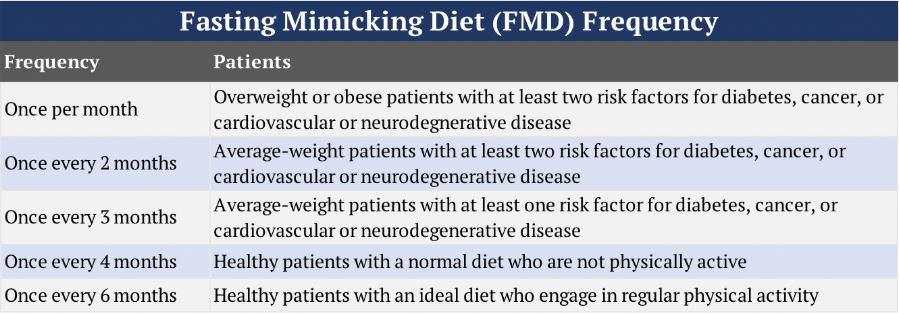
Pros
- High compliance rate (91-94% compliance)
- Rigorously studied with over $36 million and 20 years of research
- Easier psychologically than water-only
- Sleep can be significantly better than water-only fasting
- Muscle preservation
- Using the ProLon meal kits vs creating your own FMD low-calorie meals can be much more convenient, less time required for researching meals and less stressful
Cons
- Some people may feel eating a low amount of calories can be a “tease” and will make them hungrier vs when they just drink water.
- It requires a financial investment
- You will not get the gut rest that you would get from a water-only fast
If you’re interested in trying ProLon, you can get the best price and a free gift here: https://troydelaney.com/prolon
Here are a few helpful ProLon videos:
- Victoria Hahn, MS, RDN How to Prepare for Your Upcoming Fast
- Will Hsu, MD What to Expect During Your ProLon Fast
- Jeff Grimm, NP-C, FAARM: Remedies to Alleviate Symptoms Such as Hunger Pangs
- Felice Gersh, MD: The Advantage of a Prolonged Fast
- James Kelley, MD: Introducing Regular Foods Back into Your Diet
If you need more accountability, coaching support, motivation, and community power, check out my 28-DAY RESET program.
Hybrid (ProLon & Water-Only)
Another option that you may want to consider if you think you will struggle with water-only or have struggled with a prolonged fast in the past is do ProLon for 2-5 days then follow that with 2-5 more days of water-only. Using ProLon will get you over the difficult days with much less suffering while still allowing you to get a full water-fast in. I recommend two options:
- 3 Days ProLon + 2-5 days water-only. You can use the remaining two days of the ProLon meal kit for your next fast.
- Full 5-days of ProLon followed by 2-5 days water-only.
Pros
- Same as both water-only and ProLon FMD
- Allows to get over the 2/3 day hump easier and still take advantage of water-only fasting
Cons
- Same as both water-only and ProLon FMD
- May require additional days of fasting over and above the standard 3-5 days to achieve the same results
Summary of Fasting Options
- Daily TRF of 12-23 hours, such as The Leangains Method and The Warrior Diet
- Weekly or bi-weekly fasts of 20-24 hours, as detailed in Brad Pilon’s Eat, Stop, Eat, Dr. Mercola’s KetoFast or the 5:2 protocol
- Alternate Day Fasting, discussed in Dr. Jason Fung’s Complete Guide to Fasting.
- The 5-1-1 plan, detailed in Dr. Dan Pompa’s Beyond Fasting, includes 5 days of time-restricted feeding, 1 day of fasting, and 1 day of feasting each week.
- Prolonged Fasting, typically 3-10 days drinking only water; sometimes including black coffee and unsweetened tea.
- Fasting Mimicking Diet discussed by Dr. Valter Longo in The Longevity Diet, wherein you consume very low amounts of calories for 5 days as a way to experience the benefits of prolonged fasting without abstaining from food altogether. For greater convenience, you can purchase a ProLon kit which contains all five days of meals already prepared in the proper macro and calorie ratios.
- TrueNorth Health’s Therapeutic Water-Only fasting where you are medically-supervised while only drinking distilled water.
GETTING STARTED
So you’re sold on fasting and ready to start experiencing all of its benefits. Now what?
The 6-13 week process below was designed to help you easily adopt a fasting routine that works for your goals and your busy life, with the least amount of suffering and sacrifice. This is achieved by:
- Getting your body to efficiently use fat for energy (metabolic flexibility) to help the transition into a fasted state. If you are heavy to start with, or diabetic, it might take you longer to become metabolically flexible.
- Ensuring adequate electrolyte levels to prevent side effects like cramping, fatigue, dizziness, and in severe cases even blackouts
- Supporting the release of free radicals and toxins which can cause some of the negative effects of fasting.
- Providing the right exercise and protein intake to prevent muscle loss.
This is where you can choose your own adventure. For each step, select the appropriate LEVEL based on your experience and comfort:
- Beginner: No experience with the step
- Intermediate: Some experience with the step
- Advanced: Performed the step many times
Consider each step a “dial” and each level turning that dial. The higher level you choose, the faster you will see results but the more difficult it will most likely be.
You can stack STEPS 3-6 on top of each other to accelerate the process, although compliance may be more difficult. Ease into it if you think you will be able to stick to the plan better.
You can skip right to an extended fast (STEP 8) if you want, but the intention of this process is to make extended fasting easier and more enjoyable while integrating fasting into a healthy lifestyle.
If you’re interested in a fast track to a fasting lifestyle, check out my 28-DAY RESET program.
STEP 1: Choose Your Level of Fasting Experience
LEVELS:
- Beginner: No experience with fasting; follow the process step-by-step and do not jump ahead until the minimal time commitment is completed and you feel comfortable with your current level. Stick with either BEGINNER or INTERMEDIATE LEVEL for each step.
- Intermediate: Some experience with fasting; you have done 16 hour (or longer) fasts several days per week; you can probably stack one or two steps together; stick to INTERMEDIATE LEVEL.
- Advanced: You have performed a range of fast types (like OMAD or 5:2) multiple times a week and possibly a long (3+ day) fast; move through as you feel comfortable.
If you’re new to fasting and need more accountability, coaching support, motivation, and community power, check out my 28-DAY RESET program.
STEP 2: Determine Your Fasting Goals
Time Commitment: 1 day
Before you do any type of fasting, you need to first determine why you want to fast. What results and benefits are you looking for? This will help guide you on the type of fast to implement. The most common four reasons to fast are: metabolic health, weight loss, gut rest, or longevity.
I recommend everyone move on to STEP 3 and create some type of Time Restricted Feeding window because there are so many benefits to it, the risks are very low and it can be easily implemented into almost anyone’s routine. It’s an easy and quick win. Go ahead, start STEP 3 now.
STEP 3 (Easy Win): Implement a Time Restricted Feeding Window
Time Commitment: This is your base and should be done for at least two to six weeks leading up to an extended fast. But this is more of a lifestyle and should really continue as long as possible.
Recommended Frequency: 3-7 days per week
Getting hungry every now and then is clearly a healthy thing to do as long as overall caloric intake stays high enough over the course of a week to maintain a healthy weight.
For men, attempt to TRF 5-7 days per week; women may want to stick to 3-5 days per week, or maintain a shorter fasting window (10-12 hours). It’s ok to change the fasting window throughout the week. For instance, four days at 14 hours, two days at 16 and one day 12.
Here are a few key pillars of TRF:
- Do not eat or drink any calories within an hour of waking
- Do not eat or drink any calories within 2 to 3 hours before bed, ideally 3
- Maintain the same feeding window throughout the week. If your window is drifting throughout the week, that can offset a lot of the positive benefits of fasting.
- When choosing a feeding window, add one or two hours to the feeding window. For instance, if you want to do an eight hour feeding window, stick to a 10 hour feeding window. Many people miss calculate when they consume calories
-
The optimal feeding window starts between 10 AM & 12 PM and ends between 6 PM & 8 PM. Ideal is 10AM – 6PM.
- Take advantage of sleep by including this time into your fasting window. “When we sleep, our body undergoes a number of different processes in the brain and body in order to recover the cells and tissues. This [Autophagy] is a natural process that occurs and it mainly occurs during sleep.”
LEVELS:
Reminder, the higher the LEVEL, the quicker you will become metabolically flexible and the easier it will be to ease into an extended fast but the more difficult the level will be to adopt so start at the appropriate level for you.
- Beginner: 12:12 or 14:10 – Ideal for metabolic health and hormone balance
- Intermediate: 16:8 or 18:6 – Ideal for metabolic health, metabolic flexibility, weight loss and longevity
- Advanced: 20:4 or OMAD – Ideal for metabolic flexibility, weight loss and gut rest
It’s important to note that even when restricting your feeding window, you should still be consuming enough calories for the day, particularly if you’re female. It’s very difficult to squeeze in all the necessary protein and nutrients into a 2-6 hour window on a daily basis, and some days your body might need more, especially if you are exercising hard. Don’t try to discipline your way out of hunger. A prolonged caloric deficit may have a negative impact on performance, metabolism, and overall health. For females, excessive fasting and a highly compressed feeding window can lead to irregular menstrual cycles, hormone imbalances, and blood sugar dysregulation.
Per Dr. Ronesh Sinha, “Fasting is a double-edged sword where one edge of the blade can cut body fat, but the other edge can also cut essential muscle if fasting is not prescribed in conjunction with other lifestyle changes like optimal protein intake and strength training.”
To accelerate weight loss and extend the fasting window while staying satiated, consider replacing breakfast or dinner with a very small meal such as bone broth. Not only will this accelerate weight loss, bone broth can also help with sleep, benefits the microbiome and soothes and heals the gut lining while providing a potent effect on the strength of your gut flora.
You can stop at this step and still achieve many health benefits. The remaining steps enhance your body’s ability to burn fat, allowing it to become use to going for longer periods of time without food, preparing you for a longer fast and more benefits. Or just stay here until you feel comfortable to move on.
If you struggle to compress your feeding window, review the TIPS TO MAKE FASTING EASIER section.
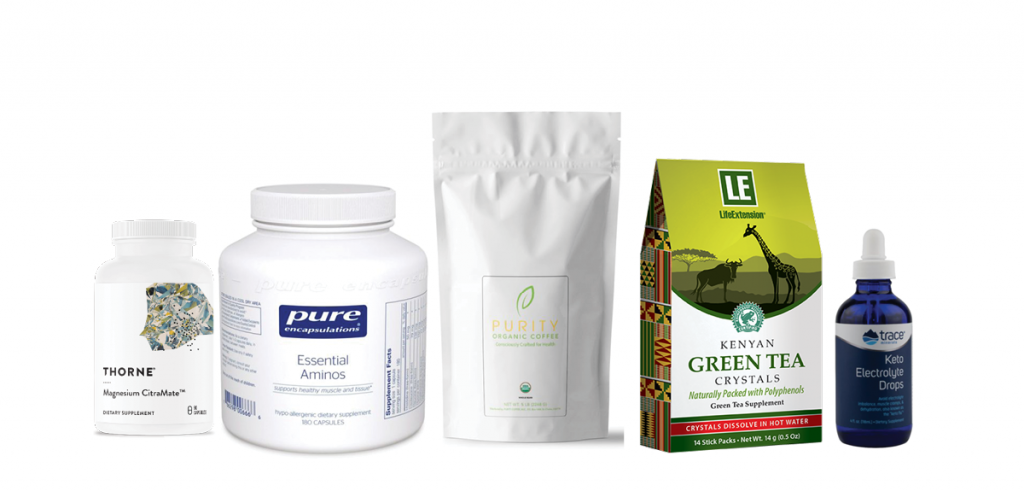
STEP 4: Measure Your Progress (Optional)
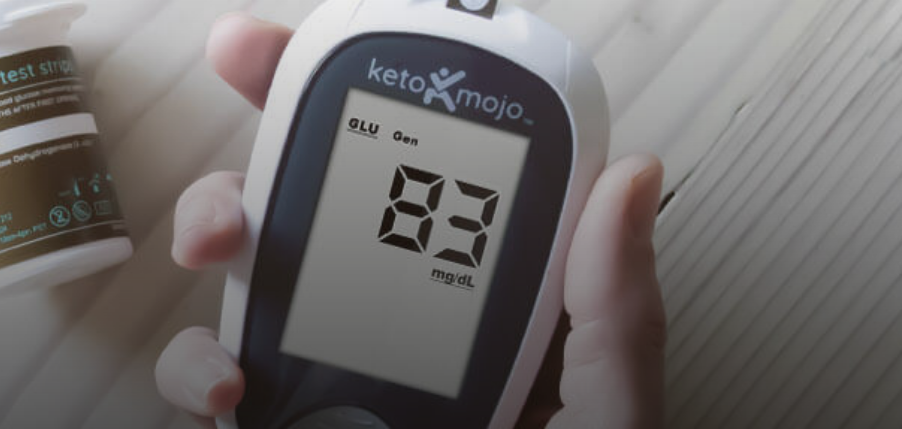
Time Commitment: 1 minute
Recommended Frequency: Every morning
So how do you track your metabolic flexibility?
Once you become metabolically flexible, you should be waking up in a state of mild ketosis every morning. Metabolically flexible people will quickly switch to the “fasted” state upon cessation of food. A good night’s sleep is enough to get the ketones flowing, even if you had carbs at dinner.
You can test your ketones each morning and confirm that you are metabolically flexible using a ketone meter like the Keto Mojo, which is one of the most accurate meters on the market. You should be measuring around 0.5 to 1.5 mmol/l. Another option that doesn’t require pricking the finger is the BIOSENSE Breath Ketone Monitoring System (Use code PATTIA20 for $20 off).
Once you can skip a meal without an issue or you are snacking less—or not at all, that is also a good indicator that you have become metabolically flexible.
The most accurate measurement is the Glucose Ketone Index (GKI) which can be measure with the Keto Mojo meter. Ideally you want a 1:2 or even better, 1:1 ratio.
Per the Keto Mojo website, “On their own, glucose or ketone readings give you a snapshot of where you are at this exact moment, which means they can be independently influenced by immediate variables, such as stress (which heightens blood glucose) or a fat-rich meal (which heightens ketones). The GKI gives you a better overall view on your metabolic status and state of ketosis because its calculation takes into account the variables and thus normalizes them, resulting in a more accurate, stable picture of your status.“
If you are heavy to start with, or diabetic, it might take you longer to shift into ketosis.
You should also track yourself periodically by monitoring body metrics (weight, waistline, body fat possibly), metabolic numbers (lipids, glucose, etc.), and performance (strength and aerobic). If you are getting weaker and/or endurance is taking a hit during exercise, you may need to refeed and put a pause on fasting while you refuel.
STEP 5: Adjust Your Diet & Hydrate

Time Commitment: 1-4 weeks leading up to an extended fast
Recommended Frequency: 6-7 days per week
Pay attention to what you are eating during the eating window. Sufficient protein, plants and other nutrient dense foods are essential. Schedule meals if you tend to under eat and stock up on protein sources or use a healthy meal delivery service to keep you on track.
Slowly start reducing your intake of foods high in both carbs and sugars, and replace them with healthy fats and high-quality proteins. When you do consume carbs, consume foods with a high amount of dietary fiber. Eat healthy fats from coconut oil, MCT oil, avocados, and olive oil, and high-quality protein from grass-fed meat, seafood, and eggs. General protein recommendations should be from 0.6 to 1.5 grams protein per pound bodyweight, depending on your activity level.
The idea is to move towards a whole-food diet and away from processed and inflammatory foods, such as alcohol, sugar, and refined carbohydrates.
Additionally, avoid frequent snacking and save most if not all of your carbohydrates for the end of the day.
You’ll also want into increase your intake of water, electrolytes and minerals to ensure adequate hydration going into a fast. This is especially important if you are doing a strict ketogenic diet, which can prevent the common “keto flu”. This can be done by increasing filtered water, mineral water and teas (Pique makes some good fasting teas) 1-2 weeks leading up to an extended fast.
I personally prefer a low-carb or ketogenic diet for 2-4 weeks leading up to an extended fast because this can shift your body from relying on glucose from carbohydrates for fuel and improve the body’s innate fat-burning capabilities. After a certain amount of time without carbohydrates, the body will naturally switch into ketosis, the process of the body using fat (ketones) for energy. This strategy can also prevent the body from catabolizing muscle during an extended fast.
LEVELS:
- Beginner: low-ish carb; cut out all added sugar and most gluten-containing grains
- Intermediate: low-carb / Paleo diet
- Advanced: strict ketogenic diet high in non-starchy vegetables
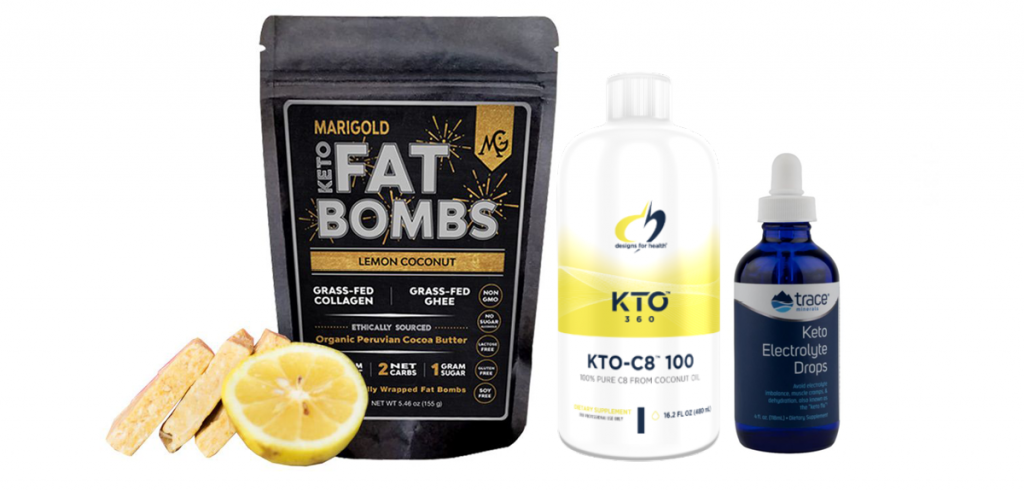
Don’t forget, you can test your progress each day by measuring your ketones in the morning with a ketone meter like the Keto Mojo. or the BIOSENSE Breath Ketone Monitoring System (Use code PATTIA20 for $20 off). If you’re in mild ketosis, you’re probably metabolically flexible. You should be measuring around 0.5 to 1.5 mmol/l.
If you want a detailed shopping list, recipes and other dietary cheatsheets, check my 28-DAY RESET program.
STEP 6: Fasted Exercise
Time Commitment: 2-4 weeks leading up to an extended fast
Recommended Frequency: 2-5 times a week
While in a fasted state preferably at the end of your fasting window, do some type of exercise. This can increase the chances of making the metabolic switch, allowing your body to tap into its own fat for fuel. Bonus: do the exercise in the morning sun for a boost of vitamin D and circadian rhythm alignment!
LEVELS:
- Beginner: 10-20 minutes of light aerobic exercise like an easy yoga session, bike ride, a leisurely swim, dog walk, yard work or even a sweat in a dry or infrared sauna. Choose anything that’s light, easy, aerobic, conversational, and low-stress.
- Intermediate: 20-40 minutes of light exercising like an easy yoga session, bike ride, a leisurely swim, or even a sweat in a dry or infrared sauna. Choose anything that’s light, easy, aerobic, conversational, and low-stress; stay physically active all day.
- Advanced: 30-60 minute workout: strength training, HIIT, or cardio (run, swim, bike, etc.); stay physically active all day.
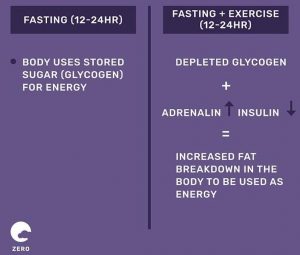
Don’t forget, you can also test your progress each day by measuring your ketones in the morning with a ketone meter like the Keto Mojo. If you’re in mild ketosis, you’re probably metabolically flexible. You should be measuring around 0.5 to 1.5 mmol/l.
If need some exercise ideas and details on the ideal exercise routine, check my 28-DAY RESET program.
Hacks to Maximized Fasted Exercise
You can boost the benefits of the fasted exercise by consuming a cup of organic coffee (I recommend Purity) or green tea (I recommend Pique) pre-workout to help mobilize fatty acids and slightly boost your metabolic rate. It has to be plain-Jane coffee or tea—no sugar, no cream, no MCT oil, no butter.
After your fasted exercise, do two to five minutes of exposure to anything cold, including a hot-cold contrast shower, a dip into a cold river or lake, or a cold bath. This will not only help strip inflammatory white adipose tissue off your belly but also increase your metabolically active brown adipose tissue, which will further enhance your capacity to burn fat.
Then consume a high protein, low carbohydrate meal to maximize your fat-burning and muscle-gaining potential.
STEP 7: Experiment with a Short Fast
Time Commitment: Attempt at least 1 24-hour fast and continue for as long as you feel comfortable.
Recommended Frequency: Anywhere from once a month to 1-2 times a week
Once you’ve followed a TRF schedule for a month — or when you have restored your metabolic flexibility and your body can efficiently use fat for fuel — you can move into the next phase by experimenting with a 24-hour, water-only fast once a week (dinner-to-dinner).
This is also a good time to experiment with either alternate-day fasting, 5:2 fasting, Eat, Stop, Eat fasting or KetoFasting, depending on your health and fitness goals.
STEP 8: Extended Fasting
Once you have a 24-48 hour fast under your belt, experiment with extended fasts (3-7 days) throughout the year. This is the true definition of “Intermittent Fasting” and addresses the top four reasons people fast: metabolic health, weight loss, gut rest, and cellular repair/longevity.
I’ve personally been doing 5-day fasts every six months since 2015 as a reboot. And it’s amazing how good you feel after you complete an extended fast.
Be sure to get a healthcare provider’s approval before attempting an extended fast.
Time Commitment: 3-10 days
Recommended Frequency: Frequency depends on your goals and how long the fasts last — short fasts (24-72 hours) may have to be done more frequently to get similar results as longer fasts (3+ days). Extended fasts can be done anywhere from once a month to once a year; up to once a month for a 3-day fast or 1-4 times a year for 5-10 day fasts. Typically, doing one extended fast a year for health and longevity seems to be a good base, more often if you are addressing health issues or trying to lose excess body fat.
Here’s the frequency the ProLon Fasting Mimicking Diet recommends based on their clinical trials:

LEVELS:
- Beginner: 3-5 day fast; consider ProLon Fasting Mimicking Diet (FMD) if you have been unsuccessful with water-only fasts in the past or are concerned you will struggle with compliance to water-only.
- Intermediate: 3-10 day fast; water-only, ProLon FMD or a Hybrid
- Advanced: Attempt a 3-10 day water-only fast or a Hybrid (3 day ProLon FMD + 2-5 days water-only)
I’ve done both ProLon and water-only extended fasts, and I personally feel ProLon is much easier and much more enjoyable (I’m an affiliate for ProLon so I do earn a commission if you purchase through my link but it’s because I’m passionate about the product and really believe in it). You can read about my first fasting experience and why I choose to do the ProLon FMD in this article along with my full review here. My personal opinion is to consider ProLon if:
- your goal is metabolic health, weight loss, cellular repair and/or longevity
- you’re looking to preserve lean muscle and don’t want to strength train during the fast (ProLon is specifically formulated to preserve lean body mass)
- you’re an athlete
- you’re female since the female body is more sensitive to caloric restriction than male physiology
- you’ve struggled with extended fasts in the past but still want the benefits of extended fasting
You can consider water-only fasting or a DIY FMD but keep in mind they have not been tested to the same rigor as ProLon’s clinical trials, along with the potential health risks and safety issues that they present.
If you’re fasting for mental fortitude, gut rest or spiritual reasons, water-only may be a better option. Although, water-only will also help with metabolic health, weight loss, cellular repair and longevity.
If you’re interested in trying ProLon, you can get the best price and a free gift here: https://troydelaney.com/prolon
I recommend reviewing the Prolonged / Extended Fasting section to get more details on your extended fasting options before making a selection.

WHAT TO EXPECT DURING AN EXTENDED FAST
Keep in mind the fasting experiences are very individualized and can even vary significantly for the same person during different fasts.
Hours 48-72 hours are typically the hardest because people tend to feel an increase in hunger during this timeframe (usually more psychological than physiological). Some report feeling slightly lethargic during this period — a cup of coffee or tea can assist with energy slumps. It’s important to pay extra attention to hydration and make sure you’re consuming plenty of electrolytes to stay energized and ward off hunger pangs.
Here’s a general overview of what to expect:
- DAY 1: Day 1 is all about priming your body to transition into an enhanced fasting state. Most people feel good and don’t really miss their normal food on Day 1. Hunger will come in waves. The most important things to do throughout your fast is to drink plenty of water.
- DAY 2: Day 2 has your body in full switch to a fat burning state. Today, cellular recycling and clean-up (autophagy) begin, while fat continues to be converted into ketones to feed your brain and other organs. Fatigue is normal as your body is starting its transformation. Remember to not overexert yourself today.
- DAY 3: Day 3 could be a challenging day as the body is getting ready for a third line of defense stem cell-based restructuring. Your body continues to be stressed and the connection pathways associated with fasting are in high gear. People tend to feel an increase in hunger during this time frame.
- DAY 4: According to Dr. Valter Longo (creator of the ProLon FMD), this is also the timeframe when autophagy up-regulates and you have an increased rate of cellular regeneration. Today your body experiences a combination of fat loss and the release of new stem cells into the blood stream. Most people report feeling more energized, better focus and less fatigue on Day 4. You may feel less hungry on this day and maybe even tempted to do intense exercise.
- DAY 5: Cellular rejuvenation continues, and your body is now an efficient performer. Younger cells are circulating, you have lost excess fat and maintained lean body mass. Most people report a continued spike in energy from the previous day and a clearer thought process. This is your body preparing you to find food and your pre-historic brain telling you “Ok, I’ve done my job and cleaned up all the useless cells – now get out there and find me that Sabertooth tiger!” Your body is prepared to hunt and gather!
- DAYS 6-10: Typically very similar to Day 5 as autophagy continues.
BREAKING AN EXTENDED FAST
Proper refeeding is a critical component of the fasting process. It’s important to develop the younger cells, grow the now more efficient body function, and maintain or grow your lean body mass. What you eat matters a lot.
The longer you fast, the longer you’ll want to take it ease back into eating. Experts in the field generally recommend starting at about 500 kcal or 50% of your normal intake and working your way up from there.
Typically starting with easily digestible foods like broths and low-sugar green smoothies. Taking digestive enzymes can also assist with the transition to solid foods.
The further out you get from your fast, the more you can relax these rules and return to your diet of choice. Your diet choices are up to you, but however you eat, it’s smart to ease back into post-fast feeding with easier-to-digest food.
Here are recommended foods to break your fast: high-quality lean protein, less-starchy, non-cruciferous vegetables, avocado, and/or bone broth or a green smoothie.
Here are recommend foods to avoid: processed high-glycemic carbs, high-lactose dairy and cruciferous vegetables.
IMPORTANT: Prior to breaking a fast, reduce cortisol levels by relaxing. I recommend Dr. Weil’s stress-relieving 4-7-8 breathing routine prior to eating. This will prevent your body from storing the food you consume in a negative way.
On Day 2, some Ghee, some resistant starch (such as cooked and cooled potatoes, and some prebiotic fibers (onion, artichoke, garlic, asparagus) to feed your good gut bacteria.
EXTENDED FASTING & EXERCISE
If you’re fasting therapeutic reasons, focus on rejuvenating, easy exercise or active recovery which allow your energy to be diverted to repair and rejuvenation.
If you’re fasting to optimize health, longevity and performance, it’s ok to experiment with more intense exercise or sauna and cold/contrast therapy. See the HACKS TO ENHANCE FASTING BENEFITS section for more details.
STEP 9: Establish a Recurring Fasting Routine
Your current behaviors are simply a reflection of your current identity. What you do now is a mirror image of the type of person you believe that you are (either consciously or subconsciously).
Sticking to Time Restricted Feeding on an ongoing basis and Intermittent Fasting throughout the year are probably the most important, most effective ways of promoting healthy aging and longevity, as well as improving and maintaining ideal body composition.
Self-experiment to find the right interval and dosing regimen. Make sure to go with what works and mix it up by including fast days, feast days and TRF days throughout the year, month or even throughout the week. Mixing it throughout the year will also help prevent plateauing.
Most importantly, listen to your body and find a sustainable routine that works for you and your schedule.
Track yourself periodically by monitoring body metrics (weight, waistline, body fat possibly), metabolic numbers (lipids, glucose, etc.), and performance (strength and aerobic). If you are getting weaker and/or endurance is taking a hit during exercise, you may need to refeed and put a pause on fasting while you refuel.
Consider working with a dietitian or coach who is experienced with prescribing and personalizing fasting. You can apply for my 1:1 coaching here.
Or if you need more help with developing a fasting routine and like a community environment, check out my 28-DAY RESET program.
ADDITIONAL INFORMATION
Potential Side Effects of Fasting
If you experience any type of negative effect (hunger is normal), it’s best to break the fast.
- Constipation
- Heartburn
- Abdominal pain
- Bloating, burping, and belching
- Nausea
- Changes in mood
- Extreme hunger
- Low energy
- Obsessive thoughts about food
- Binge eating behavior
- Headaches
- Dizziness
- Muscle loss
When You May Not Want to Fast
Fasting may not be right for you if:
- You’re suffering from chronic fatigue or HPA-axis dysregulation
- You are suffering from hormone issues
- You are very lean
- You’re a woman trying to maximize fertility, are pregnant, or breastfeeding
- You suffer from any type of eating disorder
- You’re under a lot of stress at work or at home
- You have a history of eating disorders
Supporting a Fast
Note that fasting purists recommend that anything other than water break a fast. But depending on your fasting goals, you can get away with taking certain foods and supplements to not only support but also enhance the benefits of a fast. If you are fasting for gut rest, it is best to stick with just filtered water, sparkling water, ice and bouillon.
Support for Time Restricted Feeding
Salt – 1/2 Teaspoon of salt offsets fasting-induced shakiness & lightheadedness. I like using Celtic sea salt.
Coffee – When used before and after fasted exercise, coffee can boost testosterone levels, while increasing muscle growth and recovery. Coffee has been shown to promote beneficial bacteria to proliferate and potentially reduce inflammation of the gut lining. Coffee can also lower insulin, promote the cellular clean-up process (autophagy, increase fat oxidation, activate AMPK and suppress mTOR.
Studies show [33] that caffeinated and decaffeinated coffee has appetite-suppressing properties, so opting for decaf coffee or herbal tea later in the day could offer these same benefits, without interfering with your sleep.
Tea – Tea is the ONLY doctor-approved hack that can help you stay fasted for longer with less effort (Dr. Jason Fung MD, is the world’s leading expert on fasting and 2X #1 best-selling author on fasting).
The polyphenols found in green tea can also up-regulate autophagy. And like coffee, green tea can help liberate fatty acids stored in the body while reducing hunger.
Caffeine from both coffee and tea can provide an energetic boost to help you get through the day when running low on energy during a fast.
Decaf coffee or herbal tea – Many people opt for decaf or herbal tea during a prolonged fast just to do a caffeine reset. I recommend reading this article if you plan to eliminate caffeine during an extended fast.
Most conventionally-grown coffee contains high levels of pesticides, mold and mycotoxins, and acrylamide—things you typically don’t want in your body while you’re fasting—and can often lead to jitters and an gastrointestinal distress when consumed on an empty stomach..

If you choose to drink coffee during a fast, you will likely see more benefits by opting for organic, black coffee. I recommend Purity Organic Coffee. It is a fresh-roasted, specialty grade, antioxidant-rich, medium roast coffee. Choose from regular, decaf or pods. Use code EVOLVEDNS for 10% off. Click here to buy.

If you choose to drink tea during a fast, I recommend Pique teas. They use organic tea crystals, so no steeping required. And they have an entire collection of teas specifically formulated to help you curb cravings, support satiety, and get the most from your fasting practice. Use code TROY for 5% off. Click here to buy.
MCT Oil – MCT oil is a supplement often added to smoothies, coffee, tea and salad dressings. MCT oil may help reduce fat storage, increase fat burning and accelerate the metabolic switch from using sugar to fat as fuel. I recommend Designs for Health C8. Use code VIP 5 for 15% off. Click here to buy.
Fast Bars – A premium nutrition bar created by the developers of ProLon. These provide nourishment to your body while helping to keep it in a fasting mode. These bars have been clinically tested as part of the Fasting Mimicking Diet, and are the only nutrition bars that mimic fasting. It’s a great and delicious nutrition source to satisfy any hunger pangs while extending your Time Restricted Feeding window. Click here to buy
Bone Broth – While bone broth may inhibit autophagy due to the protein content, consuming it on its own can benefit the microbiome and soothe and heal the gut lining while still getting many of the fasting benefits. It can also serve as a good food during a low-calorie fast or to break an extended fast. I recommend Kettle & Fire which derive their broths from properly and humanely-raised animals. Use code TROY for 15% off. Click here to buy
Support for a 24+ Hour Fast
Electrolytes & Minerals – It is important to supplement with electrolytes and minerals for fasts lasting longer than 24 hours. The decrease in insulin after 24 hours of fasting signals the body to flush electrolytes which are crucial for staving off fatigue, cramps, and low energy as the body taps into stored fat for energy. Make sure to choose an electrolyte supplement without sugars or additives. Simple trace minerals like this one, or even a pinch of high-quality sea salt (I recommend Celtic salt). Use code ‘VIP15’ for 15% off. PURCHASE HERE
Essential Amino Acids (EAA) – EAAs can be beneficial by promoting the maintenance of muscle, boosting cognitive function, supporting training and recovery, improving sleep, and even suppressing hunger, without hindering the benefits of a fast unless your desired goal is autophogy. In this case, avoid EAAs because they have been shown to inhibit cellular clean-up. It is also important for those that exercise during an extended fast. Use code ‘VIP15’ for 15% off. PURCHASE HERE
Digestive Enzymes – During an extended fast, your body my reduce the production of digestive enzymes. When breaking the fast, using digestive enzymes can reduce discomfort and help with the breakdown of food. Use code ‘VIP15’ for 15% off. PURCHASE HERE
Doc Parsley’s Sleep Remedy – Fasting may negatively impact sleep for a number of reasons, including increased cortisol and noradrenaline (excitatory hormones), decreased serotonin levels, and increased hunger. If you have trouble sleeping, Dr. Peter Attia recommends Doc Parsley’s Sleep Remedy supplement. Use code ‘antifragile10’ for 10% off. PURCHASE HERE
Full-Spectrum Binder – If you’re fasting to detox or lose weight, using a good full-spectrum binder is a great way to prevent negative effects of toxins being redistributed into the body. These effects can be headaches, dizziness, nausea and various other symptoms. When your body starts using fat as fuel, it can release toxins that are stored in the fat. Binders literally bind to the toxins and allow for proper elimination without the toxins ending up somewhere else in your body. Use code ‘VIP15’ for 15% off. PURCHASE HERE
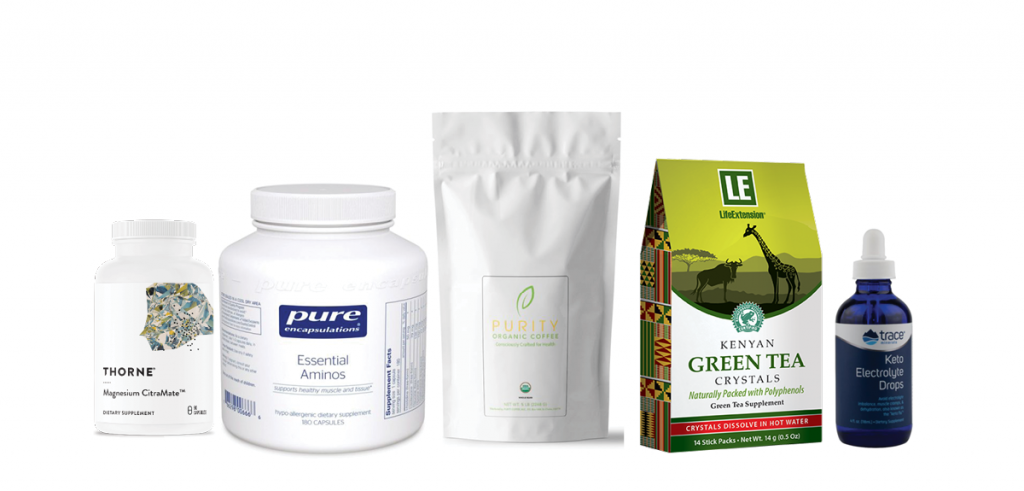
Nutrition to Support Metabolic Flexibility
Per Mark Sisson on nutrients to support metabolic flexibility:
Magnesium – Magnesium deficiency increases mitochondrial oxidative stress [34], inhibiting mitochondrial function and promoting energy overload. Magnesium deficiency has also been linked to insulin resistance.
Polyphenols: A range of polyphenol-rich foods appear to have pro-flexibility effects [35], including dark chocolate and colorful produce.
Omega-3 fats: Long chained omega-3s (found in fatty fish and fish oil) can improve mitochondrial function [36] by crowding out excessive linoleic acid in the mitochondrial membranes.
Tips to Make Fasting Easier
1. Mentally prepare —
- Be kind to yourself, stay positive, and take time to relax your mind.
- Know that hunger comes in waves – it will arise (usually around regular feeding times) and pass after about an hour. Just give it time and it will pass. Hunger is typically more psychological than physical.
- Choose to do extended fasts on days you’ll be busy which will help keep your mind off of food.
- Spend some time on gratitude and mindset work.
- Accept that you will feel hunger and embrace it instead of associating hunger with negative things. Great things are happening: your cells are revitalizing, your digestive system is getting a break, your blood sugar levels are optimizing.
2. Ensure your Self-Care is in check – Make sure to get a solid 7-9 hours of sleep each night and that you manage stress properly (here are some of the best sleep hacks). During extended fasts, dedicate at least one hour to yourself each day.
3. Drink sparkling or mineral water. The bubbles will make you feel full and the minerals will help keep you hydrated. Flavored “essence” water like La Croix are ok too, although they don’t contain minerals.
Note that consuming flavors during a fast may trigger or strengthen the feeling of hunger so proceed with caution with the following tips.
4. Add fresh lemon juice, cucumber slices or ginger to your water to encourage you to keep drinking without interfering with the benefits of your fast.
5. Boost the benefits of the fasted exercise by consuming a cup of organic coffee (I recommend Purity) or green tea (I recommend Pique) to help mobilize fatty acids and slightly boost your metabolic rate. It has to be plain coffee or tea—no cream, no sugar, no MCT oil, or no butter.
6. Salt – 1/2 Teaspoon of salt offsets fasting-induced shakiness & lightheadedness. I like using Celtic sea salt.
If you struggle sticking to just water, black coffee or unsweetened tea, try the following (in this order):
- If you really need to add a sweetener, you can add stevia, monk fruit or erythritol. No artificial sweeteners like diet soda.
- If you really need to eat something, you can eat an apple or cucumber slice or celery stick or 40 calories of fat like 1/2 Tbsp of almond butter, coconut oil, MCT oil or avocado or consume some bone broth. This will alleviate some of the discomfort. This technically breaks the fast unless you’re doing a low-calorie FMD style fast, but you will still get many of the fasting benefits.
- Fast Bars – A premium nutrition bar created by the developers of ProLon. These provide nourishment to your body while helping to keep it in a fasting mode. These bars have been clinically tested as part of the Fasting Mimicking Diet, and is the only nutrition bar that mimics fasting. It’s a great and delicious nutrition source to satisfy any hunger pangs while extending your Time Restricted Feeding window.
- “Bulletproof” or Fatty Coffee – add 1/2 Tbsp grass-fed butter and 1/2-1 tsp MCT oil to your morning (black) coffee or tea can suppress the hunger hormone until about lunchtime. But keep in mind that adding calorically dense substances into your coffee like butter and MCT oil can technically interfere with your fast so only use this temporarily until you can extend your feeding window from 6-12 hours without suffering from hunger.
7. Zero Fasting app – Great for tracking your eating window and journaling your fasting journey.
8. Replace a meal with bone broth or a green smoothie. Consuming a small meal like this only breaks the fasting window if you’re fasting for gut rest or cellular cleanup but bone broth or a smoothie can benefit the microbiome and soothe and heal the gut lining while providing a potent effect on the strength of your gut flora.
9. Fast with food — Consider the Fasting Mimicking Diet wherein you consume very low amounts of calories for five days as a way to experience the benefits of prolonged fasting without abstaining from food altogether. For greater convenience, you can purchase a ProLon kit which contains all five days of meals already prepared in the proper macro and calorie ratios.
10. Set up your social environment for success by inviting friends and family, getting an accountability buddy or joining a group fast like my 28-Day Reset. You can also join my private facebook group, Fast to PERFORM.
Struggling? Need some motivation?
- Tell yourself to keep going, you can do this, you’ll be glad you did. The food will still be there when the fast is over.
- Remind yourself why are you started the fast.
- It may help to journal your current feelings when a difficult or tempting time arises.
- Reach out to a friend, do the fast with someone or join a fasting community like my Fast to PERFORM facebook group.
- Higher a fasting coach to hold you accountable and keep you motivated.
- My favorite tip: If it becomes difficult, tell yourself “good“. Why? If it’s difficult, good things are happening…the things you’re doing the fast for are occurring and you you will be better and stronger after. Watch the video below for more motivation.
Hacks to Enhance Fasting
Get into a fasted state quicker by doing one of the following prior to starting a fast:
- High Intensity Interval Training or walking after your last calorie intake
- Take Berberine or Metformin
- Salt – Take a 1/2 tsp salt in some water after your last calorie intake. I like using Celtic sea salt.
Here are additional hacks that you can do to enhance the benefits of fasting.
1. Track yourself periodically by monitoring body metrics (weight, waistline, body fat possibly), metabolic numbers (lipids, glucose, etc.), and performance (strength and aerobic). If you are getting weaker and/or endurance is taking a hit during exercise, you may need to refeed and put a pause on fasting while you refuel.
2. Grounding/Earthing is the practice of exposing your body to the natural magnetic frequencies produced by the earth. This releases accumulated positive ions from your body. Grounding has may up-regulate mitochondrial biogenesis (the formation of the powerhouse of cells) and increase ATP (energy) production through the activation of a mitochondrial enzyme called cytochrome oxidase-c.
3. Photobiomodulation (Red/Infrared Light Therapy) – At the cellular level, visible red and near-infrared light can stimulate your cells to generate more energy, up-regulate detox pathways and undergo self-repair. This light up-regulates mitochondrial biogenesis (the formation of the powerhouse of cells) and increases ATP (energy) production through the activation of a mitochondrial enzyme called cytochrome oxidase-c which can accept energy in the form of light for enhanced cellular function. This can be achieved by utilizing a red light panel such as the GembaRed. Use code antifragile for 10% off. Click here to buy.
A full spectrum infrared sauna like the Clearlight or simply catching some rays in the sun can also have similar effects.
4. Molecular Hydrogen (H2) – H2 has been shown to increase autophogy in a fasting state. It can also scavenge hydroxyl free radicals [36a] that are released when detoxing, which can make you feel horrible. Use code ‘VIP15’ for 15% off. Click here to buy.
5. Hyperbaric Oxygen Therapy (HBOT) can enhance or up-regulate stem-cell mobilization that occurs during a fast.
6. Pulsed Electromagnetic Field (PEMF) is a type of technology that emits electromagnetic waves at different frequencies in order to stimulate and encourage your body’s natural recovery process. Combining it with fasting can enhance or up-regulate the stem-cell mobilization that occurs during a fast. [36b]
7. Whole Body Vibration Therapy / Vibration Plates may strengthen the muscles and bones [36b, 36c] and can increase circulation
and better lymph system drainage to give more rapid toxin removal. [36d]
8. Enemas, Colonics, Coffee Enemas can help to stimulate phase 1 detoxification (use a binder to catch the toxins that get released).
9. Breathwork / Meditation – Fasting is a great time to create a breathing or meditation practice. It can be as simple as two minutes of the energizing Wim Hof method or Dr. Weil’s stress-relieving 4-7-8. Consider hacking your practice with Muse which can make meditation easier through biofeedback.
10. Refeed to enhance the fasting benefits – After an extended fast, it’s important to properly feed the younger cells, grow the now more efficient body function, and maintain or grow your lean body mass. What you eat matters a lot.
- Here are recommended foods to break your fast: high-quality protein, less-starchy, non-cruciferous vegetables, avocado, and/or bone broth or a low-sugar green smoothie.
- Here are recommended foods to avoid: processed high-glycemic carbs, high-lactose dairy and cruciferous vegetables.
10. Fast-Mimicking Food – You can stimulate the same metabolic pathways and switches in your body with certain foods as you do while fasting. Some key characteristics are suppression of insulin, mTOR inhibition, increase in lipolysis, lower blood sugar, and activation of AMPK. The effects are not the same as with fasting but you can also raise basal levels of autophagy acutely.
Foods such as cayenne, black pepper, medicinal mushrooms (chaga, reishi, cordyceps), cruciferous veggies, black coffee, herbal and green tea, berberine, turmeric, ginger, apple cider vinegar, blueberries, elderberries, macadamia nut butter, olives, flax seed, and dark chocolate (100% cacao).
Adding some of these low calorie herbs and spices while your fasting may also enhance the benefits of the fast or at least extend the benefits while still consuming food.
11. Fast with Food — Consider the Fasting Mimicking Diet wherein you consume very low amounts of calories for five days as a way to experience the benefits of prolonged fasting without abstaining from food altogether. For greater convenience, you can purchase a ProLon kit which contains all five days of meals already prepared in the proper macro and calorie ratios.
If you’re healthy and fasting to optimize health, longevity and performance, consider some of the biohacks below. They are not ideal for those that are fasting for therapeutic reasons because they can serve as mild stressors. Too much stress stacked on top of fasting, which in of itself is a mild stressor, can lead to negative effects.
1. Exercise – Both cardio and resistance training activate autophagy and can mediate a lot of the physiological adaptations that occur. It imposes higher energy demands, thus enforcing cell turnover. Keep in mind that you’ll have to increase your electrolyte intake to replace what was lost in your sweat.
- Day one of an extended fast – to accelerate the benefits of a fast, perform a a tabata-style workout with equal parts work and rest. For example, 3 minutes hard effort, 3 minutes easy recover on a bike. You can do this with any type of aerobic exercise (row, elliptical, run, etc.). Dr. Peter Attia explains this hack in detail here.
- During an extended fast – To prevent depletion from an adrenal and immune standpoint, the best exercises are those that rely on the phosphagen pathway vs glycolytic pathway
- Prior to breaking an extended fast – You can take advantage of the maximum growth hormone release on day five of a fast by exercising a few hours prior to breaking the fast. Make sure to break the fast with some protein.
2. Sauna/Heat Exposure – Heat stress via a dry, wet, or infrared sauna triggers the release of heat shock proteins (HSPs), which eliminate free radicals, support antioxidant production, and repair misfolded, damaged proteins in muscle tissue. It can also up-regulate detox pathways and promote sweating to help eliminate toxins. Keep in mind that you’ll have to increase your electrolyte intake to replace what was lost in your sweat. Doing an infrared sauna session towards the end of a feeding window will help liberate stored glycogen from your cells.
If you’re interested in getting a home sauna, be sure to check out my review on the Clearlight Infrared Sauna here. Call Jenny Cross at 415.722.5354 to purchase a Jacuzzi Clearlight Infrared sauna and mention TROY for a free backrest.
3. Cold Therapy – While fasted, do two to five minutes of exposure to anything cold, including a hot-cold contrast shower, a dip into a cold river or lake, or a cold bath. This will not only help strip inflammatory white adipose tissue off your belly but also increase your metabolically active brown adipose tissue, which will further enhance your capacity to burn fat. Additionally, combining cold exposure with intermittent fasting can increase norepinephrine/ epinephrine more than either by themselves. Just make sure to go easy on the cold soaking during an extended fast because you get a huge amount of glycogenolysis so you have to be careful with excess use of the cold. Learn how I built my own chest freezer ice bath here.
4. Contrast Therapy – Exposure to heat then cold can have similar benefits to the above two options but combines both heat and cold. To get started, complete the following 5-minute daily protocol in the shower: 10 sec warm, 20 sec cold, 10x through.
5. Ozone Therapy
Fasting for Athletes & High Performers
Fasting can benefit athletes and high performers in many ways.
- Better muscle retention & body composition – Fasting can decrease and maintain low body fat while preserving lean muscle (less fat = less stress on the body = less risk of injury). Fasting stimulates the production of growth hormone and testosterone. These hormones help you maintain muscle mass [37a] while losing visceral (abdominal) fat.
-
Consider altering your feeding window if you’re trying to gain muscle.
- Fasting post workout can have a potent recovery effect and boost post-workout muscle growth [37b]
- Increase breathhold time
- Optimize cognitive performance – greater focus, clarity and energy
- Enter into a protective and stress resistant mode
- Trigger autophagy for the clean-up of old and damaged cells
- Autophagy can assist with nervous system recovery (lack of autophagy has been linked to neurodegeneration)
- Reduced inflammation & pain – Researchers have found [37b] that fasting reduces systemic inflammation and activates and increases in circulating stem cells for cellular rejuvenation
- Improved motor-skill recovery, muscle function and movement-pattern recognition
- Build mental fortitude and resiliency which can be beneficial when times get tough during competition
TIPS
- Daily TRF of 12-18 hours is popular for athletes looking to optimize their body composition without sacrificing their athletic performance because slight increases in cognitive or physical performance are typical.
- Endurance athletes may want to stick to a 8-9 hour eating window which has been linked to improved endurance (in mice). [38a]
- 10 grams of EAA (Essential Amino Acids) taken before the workout should boost post-workout recovery without taking you “out of the fast.” [37b]
- Avoid prolonged fasting (3+ days) 6-8 weeks before competition.
- Combine fasting with an exercise program like the X3 that includes strength training to maintain muscle mass.
- Avoid prolonged fasting (3+ days) if you’re overly stressed due to overtraining or excessive work/life stress or consider a ProLon fast, which can be less stressful on the body than water-only.
- Track yourself periodically by monitoring body metrics (weight, waistline, body fat possibly), metabolic numbers (lipids, glucose, etc.), and performance (strength and aerobic). If you are getting weaker and/or endurance is taking a hit during exercise, you may need to refeed and put a pause on fasting while you refuel.
- As mentioned in the Metabolic Flexibility section, when you’re fat adapted, you will be able to empty glycogen stores through intense exercise, refill those stores, burn whatever dietary fat isn’t stored, and then easily access and oxidize the fat that is stored when it’s needed. Being able to mobilize and oxidize stored fat during exercise can reduce an athlete’s reliance on glycogen. This is the classic “train low, race high” phenomenon, and it can improve performance, save the glycogen for the truly intense segments of a session, and burn more body fat.
- According to Dr. Peter Attia, resistance training during a seven or less day fast may help preserve muscle (aerobic exercise, perhaps to a lesser degree) “mechanical stress from resistance training can turn up mTOR (mTORC1, to be more specific) locally (i.e., in muscle cells), independent of growth factors and amino acids (which are the two other well-known ways to turn up this protein complex). But in the short-term (at least up to a week for most people), I believe you can maintain muscle mass while fasting, particularly if you’re resistance training.”
- See the section Hacks to Enhance the Benefits of Fasting
- Fast with food — Consider the Fasting Mimicking Diet (FMD) wherein you consume very low amounts of calories for five days as a way to experience the benefits of prolonged fasting without abstaining from food altogether. For greater convenience, you can purchase a ProLon kit which contains all five days of meals already prepared in the proper macro and calorie ratios.
The ProLon Fasting Mimicking Diet works differently than other fasts to give you the many benefits of a fast while providing essential nutrients to fuel energy levels in the body. With ProLon, athletes and high performers are able to maintain more lean body mass while lowering their body fat percentage to support athletic performance.
In addition to the fuel source while fasting, ProLon is the only FMD that still triggers autophagy in the body (a repair process in which worn out cells are cleaned up) that promotes the natural process of rejuvenation and anti-inflammation throughout the body.
ProLon is a natural, mostly plant-based diet and DOES NOT contain any human growth hormones (HGH) or performance-enhancing drugs.
If you want to learn more about using a fast to recover and rejuvenate from overtraining and still stick to a training routine, check out my 28-DAY RESET program.
Private Facebook Group
I’ve created a Facebook group full of like-minded people just like you. Stay accountable, participate in the community and share fasting stories and articles. Join my private facebook group, Fast to PERFORM here: https://www.facebook.com/groups/fasttoperfrom/
FAQ
Does ______ break a fast?
Technically, anything aside from water will break a fast because the liver must metabolize it. What breaks a fast is very contextual. Such as when was the last time you ate, what you ate, your activity, and the time within the 24 hour circadian clock schedule. But, whether something breaks your fast really depends on the benefits you are seeking from the fast. The most common three goals for fasting are: metabolic health/weight loss, gut rest, or longevity/cellular health.

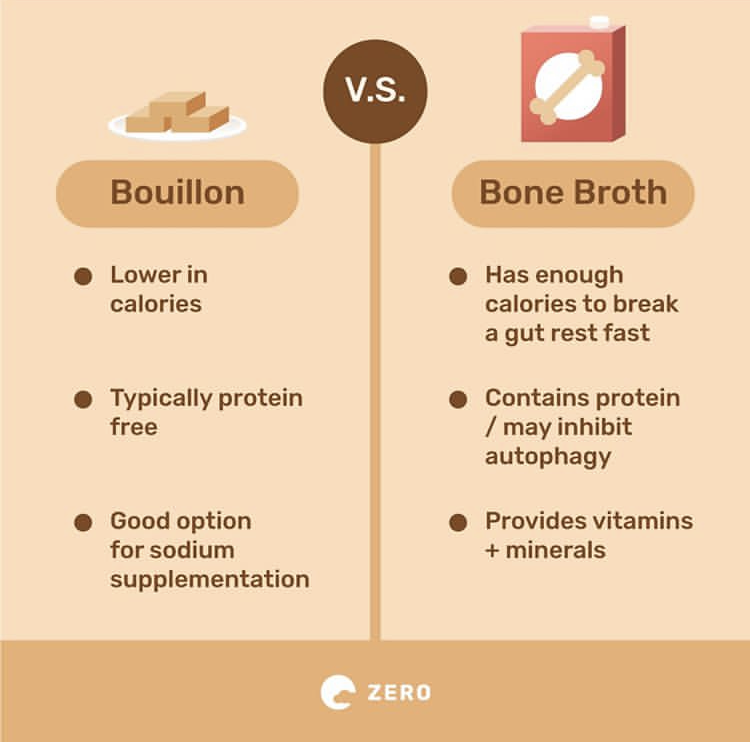


Credit: ZERO Fasting app
Does coffee or tea break a fast?
Most evidence suggests that black coffee or unsweetened tea do not “break a fast”, meaning they don’t prevent the benefits of fasting when it comes to metabolic health, weight loss, or autophagy. In fact, coffee and tea have been shown to enhance many of these beneficial effects. However, when you start to add calories to your coffee or tea in the form of sugar, cream, butter, or MCT oil, the benefits of fasting may decrease. Since both coffee and tea do trigger some digestive functions, it may be best to avoid if you’re fasting for a gut reset.
Summary:
- Fasting for metabolic health/weight loss: probably does not break a fast (and likely enhances the benefits)
- Fasting for gut rest: does break a fast
- Fasting for energy or mental clarity: probably does not break a fast (and likely enhances the benefits)
- Fasting for longevity: probably does not break a fast (and likely enhances the benefits)




ICredit: ZERO Fasting app
If you choose to drink coffee during a fast, you will likely see more benefits by opting for organic, black coffee. I recommend Purity Organic Coffee. It is a fresh-roasted, specialty grade, antioxidant-rich, medium roast coffee. Choose from regular, decaf or pods. Get 10% off with code EVOLVEDNS here: https://troydelaney.com/coffee
If you choose to drink tea during a fast, I recommend Pique teas. They use organic tea crystals, so no steeping required. And they have an entire collection of teas specifically formulated to support your fasting goals. You can purchase Pique here (Use code TROY for 5% off): https://troydelaney.com/pique
Does fasting cause hormonal imbalances?
Fasting is a hormetic stressor (but so is exercise). Just like over-exercising, inappropriate fasting can disrupt hormones in some. But just like exercise and other hormetic stressors, fasting is a GOOD stress. It turns on mechanisms that improve metabolism, longevity, and brain health. The dose and the person’s baseline is important here. Low dose and slow increase can be quite safe in most. So don’t be afraid of fasting because “someone” told you it’s bad for hormones.
Fasting can cause a temporary reduction in thyroid hormone T3, which plays a role in metabolism and energy production. However, T3 production returns to normal once feeding is resumed. This re-uptake of metabolism and thyroid hormone is a benefit that is unique to fasting, as it doesn’t occur during long-term calorie restriction. [39]
Will fasting kill my metabolism?
It’s true that restricting calories leads to a slow metabolism. But fasting works in the body differently. Your body can use fuel from two sources: glycogen (basically, the stuff you’re eating and digesting that’s readily available), or stored body fat.
The problem is, our body can only access the stored fat if insulin levels are very low.
So if you simply restrict your calories, but you keep eating all day long, your body will run out of glycogen to burn, AND it can’t get to the stored fat, because your insulin levels are still too high.
The result? Insufficient fuel to keep your metabolism burning.
But when you fast, your insulin levels drop, allowing your body to access stored fat to use as fuel.
So from your metabolism’s perspective, it’s still getting plenty of fuel — it’s getting all your body fat to burn! This is why some people actually experience increased metabolism after several days of fasting.
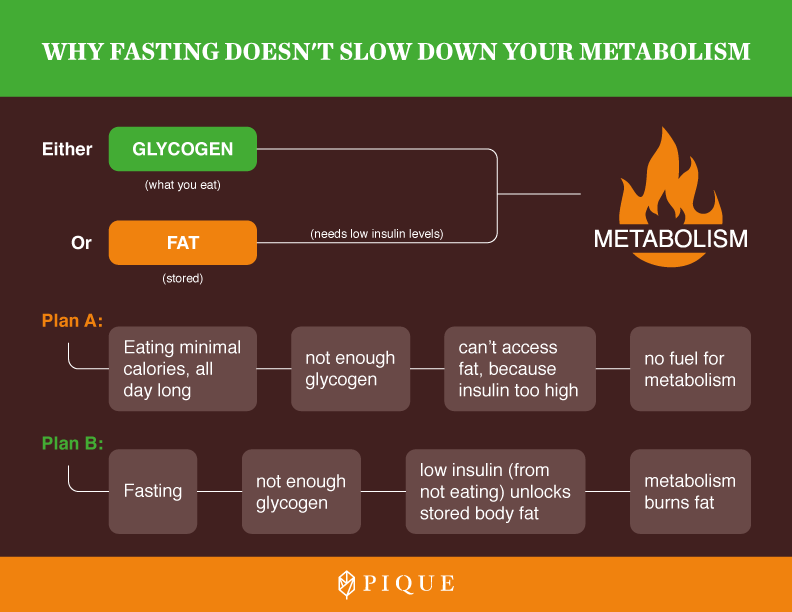
Products Mentioned
Here is a list of all the products mentioned that can assist with your fasting goals while making fasting easier and more enjoyable. Keep in mind, you don’t need anything to start fasting other than the mindset.
- ProLon Fasting Mimicking Diet kit – If you’re interested in trying ProLon, you can get the best price and a free gift here (use my name Troy Delaney when it asks for ‘Provider’ and code HCRTDelaney for an a discount): https://troydelaney.com/prolon
- Fast Bar – Extend your fast or use as a night snack
- Purity organic coffee – Use code EVOLVEDNS for 10% off
- Pique organic tea crystals – Use code TROY for 5% off
- Kettle & Fire Bone Broth – Use code TROY for 15% off
- Doc Parsley Sleep Remedy – Use code antifragile10 for 10% off
- Trace Minerals Keto Electrolyte Drops – Use code VIP15 for 15% off
- Thorne Research Digestive Enzymes – Use code VIP15 for 15% off
- Pure Encapsulations Essential Amino Acids – Use code VIP15 for 15% off
- Design for Health MCT oil – Use code VIP15 for 15% off
- Quicksilver Scientific Full-Spectrum Binder and Molecular Hydrogen – Use code VIP15 for 15% off
Resources
- The Leangains Method by Martin Berkhan
- The Warrior Diet by Ori Hofmekler
- Eat, Stop, Eat by Brad Pilon
- The Complete Guide to Fasting by Dr. Jason Fung, M.D.
- The Official Site of Dr. Dan Pompa, D.C.
- The Longevity Diet by Valter Longo, PhD
- Rhonda Patrick, PhD
- Ben Greenfield & Kion
- The Salk Institute official site, Dr. Satchidananda Panda on Time Restricted Feeding
- The Official site of Peter Attia, M.D.
- Zero app – If you need help tracking your eating window and would like to journal your fasting journey, the Zero app is very helpful
Consider working with a dietitian or coach who is experienced with prescribing and personalizing fasting. You can apply for my 1:1 coaching here.
SPECIAL OFFER
Ready to give an extended fast a try?
I’m an affiliate for the ProLon Fasting Mimicking Diet so I have access to the best prices on the 5-day mealkits. Plus you’ll get a free gift here: https://troydelaney.com/prolon
Join the 28-DAY RESET
Join my 28-DAY RESET Group Fast which includes the 5-day ProLon meal kit, four weeks of daily lessons, full coaching support, motivation, community power, accountability, and more!
Here’s what you’ll get:
- One 5-day ProLon meal kit ($249 value)
- Daily lessons throughout the 28 days
- My 10 Tips for Completing an Extended Fast download
- Complimentary coaching session with a ProLon dietitian or nurse practitioner
- Free shipping
- Much more (click Learn More for details)
Disclosure: Please note that some of the links above are affiliate links, and at no additional cost to you, I will earn a commission if you decide to make a purchase. Oftentimes, I’ve worked out a discount for you. Please understand that I have experience with all of the products I’m an affiliate for, and I only recommend them because they are helpful and useful, not because of the small commissions I make if you decide to buy something. Please do not spend any money on these products unless you feel you need them or that they will help you achieve your goals.
